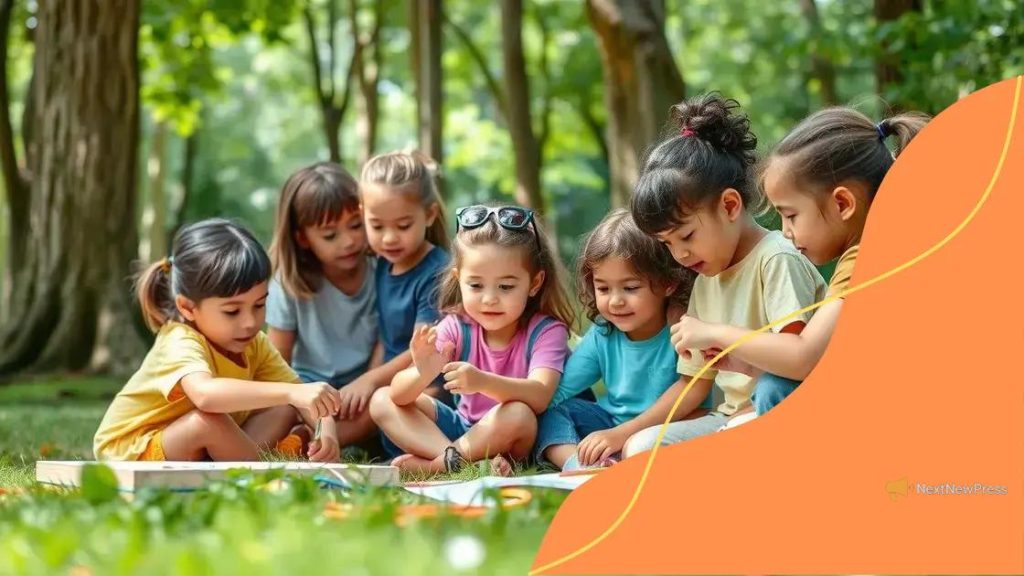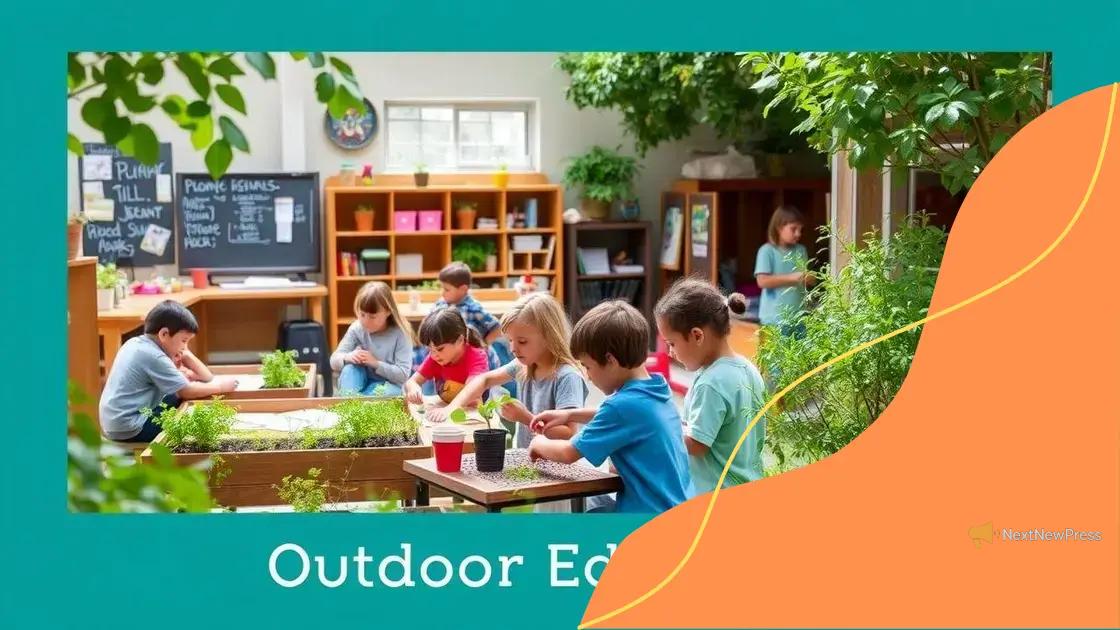Importance of outdoor learning in child development

The importance of outdoor learning lies in its ability to enhance students’ physical health, social skills, and engagement by connecting classroom lessons to real-world experiences in a natural environment.
Importance of outdoor learning is becoming increasingly recognized in today’s educational landscape. Have you noticed how much kids engage when they’re outside? Let’s explore why outdoor experiences matter.
Understanding the concept of outdoor learning
When we talk about outdoor learning, we’re referring to educational experiences that take place outside the traditional classroom walls. This concept encourages students to explore nature, engage with their surroundings, and develop a deeper understanding of the world around them. Notably, it promotes active participation, allowing learners to discover new interests and skills.
Key Elements of Outdoor Learning
Outdoor learning encompasses various aspects that make it effective and enriching. Each element contributes to a holistic educational experience.
- Experiential Learning: Students gain insights through hands-on activities.
- Critical Thinking: They analyze the environment and solve problems creatively.
- Social Skills: Interacting with peers in natural settings fosters teamwork.
- Emotional Well-being: Nature has a calming effect that enhances mental health.
The importance of outdoor learning extends beyond academic success. Children become more aware of their impact on the environment, fostering a sense of stewardship. By spending time outdoors, students not only improve their knowledge but also develop a love for nature. This connection encourages them to care about conservation and sustainability, which are crucial for our planet’s future.
Benefits for Students
Research indicates that engaging with nature improves student focus and energy levels. Many educators have recognized that integrating outdoor experiences into their curricula can lead to better learning outcomes. Students often retain information better when they learn in a dynamic environment, which makes outdoor learning a valuable addition to modern educational practices.
Furthermore, outdoor learning can also bridge the gap between theoretical knowledge and practical application. For instance, studying plants in a garden allows students to see concepts in biology come to life. Such experiences not only validate classroom theories but also make learning enjoyable.
Benefits of outdoor learning for children
The benefits of outdoor learning for children are extensive and impactful. Engaging in outdoor experiences supports children’s overall development in various ways. From physical health to social skills, outdoor settings create unique opportunities for learning that cannot be replicated indoors.
Physical Health Advantages
One significant aspect of outdoor learning is its positive influence on physical health. Being outside encourages children to be active, promoting fitness and a healthy lifestyle.
- Improved coordination and balance through active play.
- Opportunities for running, climbing, and exploring, which enhance fitness.
- Exposure to sunlight helps in the production of Vitamin D.
- Better overall health leading to fewer doctor visits.
Additionally, outdoor learning experiences allow children to interact with various environments. This can spark interest in physical education and promote lifelong habits of health and wellness. Spending time outdoors also reduces stress and anxiety, making it a natural remedy for some of the pressures children face today.
Social Skills Development
Another remarkable benefit is the improvement of social skills. When children engage in outdoor activities, they often work in groups. This collaboration fosters teamwork and communication.
Outdoor settings encourage children to take challenges together. They learn how to negotiate roles, resolve conflicts, and share responsibilities. For instance, a simple game of tag can teach important lessons about turn-taking and sportsmanship. As they interact outside of the classroom environment, children build friendships through shared experiences, making learning more enjoyable and memorable.
Furthermore, outdoor learning helps boost creativity. Nature serves as a fantastic backdrop for imaginative play. Exploring the outdoors stimulates curiosity and problem-solving skills. Children often find themselves discovering new interests while being encouraged to think outside the box.
Incorporating outdoor activities in education

Incorporating outdoor activities in education can transform the learning experience for students. By integrating nature into curriculums, educators provide unique opportunities for hands-on learning that enrich classroom lessons. This approach not only captivates students but also enhances their retention of knowledge.
Types of Outdoor Activities
There are various ways to bring outdoor activities into education, and each type offers distinct learning benefits. These activities can range from simple exercises to complex projects that require critical thinking.
- Field trips: Visiting local parks, museums, or farms to engage students with real-world concepts.
- Gardening: Teaching kids about biology and sustainability by having them plant and maintain a garden.
- Nature walks: Encouraging exploration and observation skills as students discover local flora and fauna.
- Outdoor science experiments: Conducting experiments outside to connect scientific principles with the natural world.
Implementing outdoor activities allows educators to emphasize experiential learning. For example, when studying ecosystems, a field trip to a nearby wetland can help students understand interdependence among species. Such experiences turn abstract concepts into tangible realities, making learning more effective.
Creating a Supportive Environment
To effectively incorporate outdoor learning, it’s essential to create a supportive environment. Teachers should work to establish guidelines that ensure safety while encouraging exploration. Collaboration with parents and the community can enhance resources and provide additional support.
Another key component is adaptability. Teachers should be open to modifying lessons based on the weather or the interests of the students. By designing flexible plans, they can seize spontaneous opportunities that spark curiosity.
Moreover, integrating outdoor activities encourages collaborative skills among students. They often work in teams to complete tasks, fostering communication and cooperation. This group dynamic not only strengthens relationships but also prepares students for real-world interactions.
Challenges faced in outdoor learning
While outdoor learning offers numerous benefits, there are also significant challenges faced in outdoor learning. Recognizing these obstacles is essential for effectively incorporating outdoor experiences into educational settings.
Weather Conditions
One of the most prominent challenges is unpredictable weather. Rain, extreme heat, or cold can disrupt planned activities. To manage this, educators should have backup plans and flexible schedules. It’s crucial to prepare students with appropriate clothing and gear to ensure safety and comfort during outdoor lessons.
- Monitoring local weather forecasts before outings.
- Establishing indoor alternatives when needed.
- Educating students on dressing appropriately for outdoor conditions.
Adapting lessons based on the weather can keep students engaged and excited about learning outside.
Resource Availability
Another challenge is the availability of resources and safe outdoor spaces. Not all schools have easy access to parks or natural environments. Some educators may have to get creative, using school grounds or even local community spaces for outdoor activities. Collaborating with community organizations can provide access to more diverse environments.
Limited resources may lead educators to feel unprepared. They might worry about safety or lack necessary materials for outdoor activities. Therefore, planning is vital. Educators should utilize available materials wisely and seek community support to enhance outdoor learning experiences.
Student Engagement
Furthermore, ensuring all students are engaged and focused during outdoor activities can be challenging. Some may feel distracted by the environment or may not be as enthusiastic about outdoor learning. To counter this, teachers can develop interactive and structured activities that promote participation from every child.
Using clear instructions, setting goals, and fostering teamwork can help maintain attention. Incorporating environmental themes into the curriculum can also boost interest and relevance for students.
Practical tips for implementing outdoor learning
Implementing outdoor learning in schools can be a rewarding experience. Here are some practical tips for implementing outdoor learning effectively and engagingly.
Plan and Prepare
Before heading outdoors, careful planning is essential. Begin by setting clear goals for your outdoor lessons. Decide what you want students to learn and how outdoor experiences will enhance their understanding.
- Make a checklist of activities and materials needed for each lesson.
- Scout locations ahead of time to ensure safety and accessibility.
- Involve students in the planning process to boost excitement.
Preparation helps create a structured yet flexible learning environment that can adapt to the outdoor setting.
Incorporate Multidisciplinary Approaches
Outdoor learning can cover various subjects. Link lessons to multiple curriculum areas, such as science, art, and physical education. For example, students can study plants and animals in a science lesson, then create nature-inspired art.
This integrated approach fosters deeper connections between different subjects, making learning more relevant and enjoyable.
Engage with Nature
Take advantage of the natural environment. Encourage students to observe their surroundings actively. Ask guiding questions to spark critical thinking. For instance, “What patterns do you notice?” or “How does this ecosystem support life?”
Hands-on activities can deepen their understanding. Encourage exploration by providing tools for measuring, collecting, or documenting observations. For example, students can use magnifying glasses to explore leaves or collect samples of soil.
Foster Community Involvement
Engaging the community can enhance outdoor learning experiences. Reach out to local organizations or experts who can assist in lessons. Community members can share their knowledge or resources, enriching the learning environment.
Furthermore, involving parents can create a sense of ownership and support for outdoor initiatives. Consider hosting family days where students can showcase their outdoor projects and activities.
FAQ – Common Questions About Outdoor Learning
What are the main benefits of outdoor learning?
Outdoor learning promotes physical health, enhances social skills, and increases student engagement by connecting lessons to real-life experiences.
How can teachers overcome challenges in outdoor learning?
Teachers can prepare by planning activities in advance, using flexible scheduling, and finding alternative locations for lessons.
What types of outdoor activities can be included in the curriculum?
Activities can include field trips, gardening, nature walks, and outdoor science experiments, all of which encourage hands-on learning.
How can the community support outdoor learning initiatives?
Community involvement can provide resources, local expertise, and opportunities for collaboration, enriching outdoor learning experiences for students.





